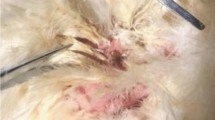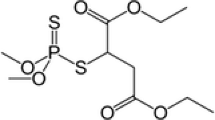Abstract
A laboratory evaluation of fenbuconazole, myclobutanil propiconazole, boscalid, fenhexamid and pyraclostrobin revealed these fungicides to be harmless to adult Galendromus occidentalis. None of these fungicides affected adversely fecundity and egg viability. Elemental sulphur also had no effect on adults and fecundity. However, 72.4% of the young larvae perished after hatching. The six novel fungicides are safer alternatives to sulphur in perennial crops in British Columbia.
Similar content being viewed by others
References
Alston DG, Thomson SV (2004) Effects of fungicide residues on the survival, fecundity, and predation of the mites Teytranychus urticae (Acari: Tetranychidae) and Galendromus occidentalis (Acari: Phytoseiidae). J Econ Entomol 97:950–956. doi:10.1603/0022-0493(2004)097[0950:EOFROT]2.0.CO;2
Anonymous (2002a) Crop profile for apples in British Columbia, crop group 11, pome fruits. British Columbia Ministry of Agriculture, Food and Fisheries (modified January 2003)
Anonymous (2002b) Crop profile for sweet cherries in British Columbia, crop group 12, stone fruits. British Columbia Ministry of Agriculture, Food and Fisheries (modified January 2003)
Baynon GT, Penman DR (1987) The effects of mancozeb and metiram on the predatory mite, Typhlodromus pyri. Proceedings of the New Zealand weed pest control conference 104–107
Bernard MB, Horne PA, Hoffmann AA (2004) Developing an ecotoxicological testing standard for predatory mites in Australia: acute and sublethal effects of fungicides on Euseius victoriensis and Galendromus occidentalis (Acarina: Phytoseiidae). J Econ Entomol 97:891–899. doi:10.1603/0022-0493(2004)097[0891:DAETSF]2.0.CO;2
Bostanian NJ, Larocque N (2001) Laboratory tests to determine the intrinsic toxicity of four fungicides and two insecticides to the predacious mite Agistemus fleschneri. Phytoparasitica 29:215–222
Bostanian NJ, Thistlewood H, Racette G (1998) Effects of five fungicides used in Quebec apple orchards on Amblyseius fallacis (Garman) (Phytoseiidae: Acari). J Hortic Sci Biotechnol 73:527–530
Bostanian NJ, Larocque N, Vincent C, Chouinard G, Morin Y (2000) Effects of five insecticides used in apple orchards on Hyaliodes vitripennis (Say) (Hemiptera: Miridae). J Environ Sci Health B 35:143–155
Croft BA (1990) Arthropod biological control agents and pesticides. Wiley, New York, NY, USA
Croft BA, Nelson EE (1972) Toxicity of apple orchard pesticides to Michigan populations of Amblyseius fallacis. Environ Entomol 1:576–579
Cross JV, Berrie AM (1996) Further field evaluation of the effects of repeated foliar sprays of insecticides or fungicides alone and in a mixture on an organophosphate-resistant strain of the orchard predatory mite Typhlodromus pyri on apple. Crop Prot 15:637–639. doi:10.1016/0261-2194(96)00030-0
Cuthbertson AGS, Murchie AK (2003) The impact of fungicides to control apple scab (Venturia inaequalis) on the predatory mite Anystis baccarum and its prey Aculus schlechtendali (apple rust mite) in Northern Ireland Bramley orchards. Crop Prot 22:1125–1130. doi:10.1016/S0261-2194(03)00147-9
Debieu D, Bach J, Hugon M, Malosse C, Leroux P (2001) The hydroxyanilide fenhaximid, a new sterol biosynthesis inhibitor fungicide efficient against the plant pathogen fungus Botryotinia fuckeliana (Botrytis cinerea). Pest Manag Sci 57:1060–1067. doi:10.1002/ps.394
Downing RS, Arrand JC (1968) Integrated control of orchard mites. BC Orchardist 8:13
Gambaro PI (1991) Comparison between the population dynamics of Amblyseius andersoni in different apple orchards protected by ‘Supervised Control’ Programmes. Informatore-Agrario 47:73–75
Grande C, Ingrassia S, Grande M (1989) Effects of dithiocarbamates on beneficial arthropods of table grapes. Informatore-Agrario 45:121–123
Hanna R, Zalom FG, Wilson LT, Leavitt GM (1997) Sulfur can suppress mite predators in vineyards. Calif Agric 51:19–21
Hardman JM, Franklin JL, Jensen KIN, Moreau DL (2006) Effects of pesticides on mite predators (Acari: Phytoseiidae) and colonization of apple trees by Tetranychus urticae. Phytoparasitica 34:449–462
Henderson CF, Tilton EW (1955) Tests with acaricides against the brown wheat mite. J Econ Entomol 48:157–167
Horsfall JG (1956) Principles of fungicidal action. Chronica Botanica Company, Waltham, Massachussetts, USA
Hoy MA, Standow KA (1981) Resistance to sulfur in a vineyard spider mite predator. Calif Agric 35:8–10
Hoyt SC (1969) Integrated chemical control of insects and biological control of mites on apple in Washington. J Econ Entomol 62:74–86
Institue SAS (2002) Statistics and graphics guide, vol 5. SAS Institute Inc., Cary, NC, USA
Ioriatti C, Pasqualini E, Toniolli A (1992) Effects of the fungicides mancozeb and dithianon on mortality and reproduction of the predatory mite Amblyseius andersoni. Exp Appl Acarol 15:109–116. doi:10.1007/BF01275521
Laurin M-C, Bostanian NJ (2007) Short-term contact toxicity of seven fungicides on Anystis baccarum. Phytoparasitica 35:380–385
LeClerg ER, Leonard WH, Clark AG (1966) Field plot technique. Burgess Publishing Company, Minneapolis, Minnesota, USA
Mattioda H, Auger P, Kreiter S (1999) Le mancozèbe et Typholodromus pyri. Phytoma 513:44–47
Nakashima MJ, Croft BA (1974) Toxicity of benomyl to the life stages of Amblyseius fallacis. J Econ Entomol 67:675–677
Prischmann DA, James DG, Wright LC, Teneyck RD, Snyder WE (2005) Effects of chlorpyrifos and sulfur on spider mites (Acari: Tetranychidae) and their natural enemies. Biol Control 33:324–334. doi:10.1016/j.biocontrol.2005.03.008
Rock G, Yeargan RR (1970) Relative toxicity of plictran miticide to the European red mite, the two spotted spider mite and the predacious mite Neoseiulus (Typhlodromus) fallacis (family: Phytoseiidae). Down to Earth 26:1–4
Rosslenbroich H-J, Stuebler D (2000) Botrytis cinerea history of chemical control and novel fungicides for its management. Crop Prot 19:557–561. doi:10.1016/S0261-2194(00)00072-7
Schwartz A (1991) Laboratory evaluation of toxicity of registered pesticides to adult Amblyseius addoensis (Van der Merwe and Ryke) (Acari: Phytoseiidae). S Afr J Enology Vitic 12:87–89
Williams JS, Cooper RM (2004) The oldest fungicide and newest phytoalexin: a reappraisal of the fungitoxicity of elemental sulphur. Plant Pathol 53:263–279. doi:10.1111/j.0032-0862.2004.01010.x
Acknowledgements
We thank the following trainees from Sherbrooke University: Eric Allard, Philippe Trudel, Guillaume Bastille-Rousseau, Josée Hamel, Bruno Proulx, as well as, Anouk Hebert and Dany Roy-Binette from the Federal Public Sector Youth Internship Program of Canada, for laboratory assistance. Hugh Philip from British Columbia Ministry of Agriculture, Food and Fisheries is thanked for the original collection of G. occidentalis in the Okanagan valley. The manufacturers of the fungicides are graciously thanked for the free samples of their products. Funding was provided in part by the Improved Farming Systems and Practices Initiative of the Pest Management Centre, Agriculture and Agri-Food Canada.
Author information
Authors and Affiliations
Corresponding author
Rights and permissions
About this article
Cite this article
Bostanian, N.J., Thistlewood, H.M.A., Hardman, J.M. et al. Toxicity of six novel fungicides and sulphur to Galendromus occidentalis (Acari: Phytoseiidae). Exp Appl Acarol 47, 63–69 (2009). https://doi.org/10.1007/s10493-008-9191-5
Received:
Accepted:
Published:
Issue Date:
DOI: https://doi.org/10.1007/s10493-008-9191-5




